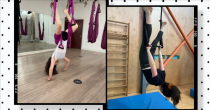“I tried aerial yoga as a fitness beginner – here’s why it’s become my new hobby”
Looking for a way to elevate your workout? Tasha Kleeman, writer and founder of mental health community The Recovery Club, explores the dizzy heights of aerial arts.
There are many words my friends might use to describe me, but graceful is not one of them. I’m clumsy, not very flexible and generally pretty fearful. As a child, I was so frightened of going upside down that I couldn’t do a forward roll.
So when a friend suggested I join her for an aerial hoop class, it was an easy ‘no’ from me. OK, it was more of a ‘What on earth is that?’ (think yoga, but in a metal hoop suspended in the air), followed by a swift no.
Alas, that offer came in the middle of a five-month remote working adventure in Berlin –when I’d committed to saying ‘yes’ to any new opportunities that came my way. And so, I reluctantly joined her.
You may also like
Reformer pilates has taken the fitness world by storm, but what happens in a core-blasting class?
The class took place in a brightly coloured studio on the river Spree (Flair Studios, for any thrill-seeking Berliners out there). Metal rings stood suspended (alarmingly high) above giant crash mats, which we approached after a whistle-stop cardio, ab and shoulder warm-up. We moved from shoulder rolls (hands raised to the hoop, body in a chair position), to more ambitious straddles (hands on the hoop, body inverted, legs out to each side), before finally learning how to get into the hoop (full disclosure: this took me about three classes to master) and getting to grips with some of the basic moves.
As I watched my classmates contorting their bodies into impressive shapes while somehow balancing in the thin metal hoop, I was convinced that this kind of exercise wasn’t for me. I left with adrenaline pumping through my body and the dizzy high of having faced a fear. It was terrifying.
But I came back for one more class, and then another. Each time, I pushed myself a little further and found new sources of strength. Moves that felt impossible in my first few classes (hanging from my knees, rolling forwards over the hoop with just one knee attached) no longer seemed so scary.

When I moved back home to the UK, I continued classes at the London Dance Academy and have since experimented with aerial yoga and static trapeze (this time at Flying Fantastic).
I’m still a beginner, but I’ve already gained so much from aerial yoga. There’s something so liberating about overcoming my fears in a safe environment, and in a world of tax returns and adult responsibilities, there’s something delightfully regressive about hanging upside down and playing around above giant crash mats.
Benefits of aerial fitness for body image and mental health
What I love most about aerial is its focus is on what your body can do, rather than what it looks like. Classes are made up of individuals of all shapes, sizes and backgrounds, and there’s an emphasis on expanding your body’s capabilities and on joyful, playful movement. There’s lots of laughing, falling over and supportive encouragement.
Tanya Rashid, an aerial hoop instructor at the London Dance Academy, explains, “Aerial is a workout that also develops a craft. You’re not only developing your fitness, but you’re also becoming proficient in an art form. While focusing on the technical aspects of moves in class, students often forget that they’re exercising!”
You may also like
Fitness challenge: “I held a plank every day for a month – this is what happened”

This isn’t to say that aerial isn’t a hardcore workout. (The day after my first class, I could barely lift my arms over my head). It’s intense on your body, requiring a strong core and regular practice. As Rashid points out, it also motivates you to build up muscle outside of the class, since the more advanced moves require “a strong level of overall fitness”.
She adds: “Most of the women who have been coming to my classes regularly are now stronger than most of my guy friends who ‘work out’.”
What other forms of aerial fitness are there?
Aerial has its roots in circus acrobatics, and as an art form sits somewhere between gymnastics, burlesque and circus arts. As well as hoop, trapeze and the hammock-based aerial toga, there’s silks, straps and tope. Those who perform professionally exhibit a level of skill and artistry that’s incredible to watch: this is one YouTube rabbit hole you won’t regret falling down.

How much gym experience do you need to try aerial fitness?
You don’t need to be an aspiring acrobat to get into aerial fitness. And you don’t need to be super strong or even particularly flexible. Rashid agrees. “You absolutely do not have to have a certain level of fitness or body type to be good at aerial hoop”, she says. However, it does require some graft: “All my students who have kept coming back to class, regardless of body type, have shown a commitment and dedication to the hard work it takes to build up the strength required to progress in the field.”
If you’d told me a year ago I’d be attending hoop and trapeze classes, I would never have believed you. But now it’s the highlight of my week: a space where I can go and forget the noise of daily life and focus purely on the shape I’m trying to create. It’s also probably the closest I’ll ever get to flying.
Images: Tasha Kleeman
Source: Read Full Article
